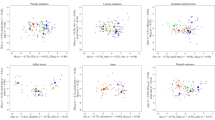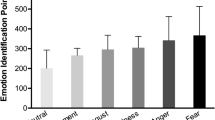Abstract
This research examines the correspondence between theoretical predictions on vocal expression patterns in naturally occurring emotions (as based on the component process theory of emotion; Scherer, 1986) and empirical data on the acoustic characteristics of actors' portrayals. Two male and two female professional radio actors portrayed anger, sadness, joy, fear, and disgust based on realistic scenarios of emotion-eliciting events. A series of judgment studies was conducted to assess the degree to which judges are able to recognize the intended emotion expressions. Disgust was relatively poorly recognized; average recognition accuracy for the other emotions attained 62.8% across studies. A set of portrayals reaching a satisfactory level of recognition accuracy underwent digital acoustic analysis. The results for the acoustic parameters extracted from the speech signal show a number of significant differences between emotions, generally confirming the theoretical predictions.
Similar content being viewed by others
References
Ekman, P., & Friesen, W. V. (1969). The repertoire of nonverbal behavior: Categories, origins, usage, and coding.Semiotica, 1 49–98.
Ekman, P., Friesen, W. V., & O'Sullivan, M. (1988). Smiles when lying.Journal of Personality and Social Psychology, 54 414–420.
Fairbanks, G., & Hoaglin, L. W. (1941). An experimental study of the duration characteristics of the voice during the expression of emotion.Speech Monographs, 8 85–90.
Fleiss, L. J. (1981).Statistical methods for rates and proportions. New York: Wiley.
Frokjaer-Jensen, B., & Prytz, S. (1976). Registration of voice quality.Bruel and Kjaer Technical Review, 3 3–17.
Gellhorn, E. (1970). The emotions and the ergotropic and trophotropic systems.Psychologische Forschung, 34 48–94.
Goffman, E. (1979). Response cries. In M. von Cranach, K. Foppa, W. Lepenies, & D. Ploog (Eds.),Human ethology (pp. 203–240). Cambridge, England: Cambridge University Press.
Hall, J. A. (1984).Nonverbal sex differences: Communication accuracy and expressive styles. Baltimore: Johns Hopkins University Press.
Nolan, F. (1983).The phonetic bases of speaker recognition. Cambridge, England: Cambridge University Press.
Rosenthal, R., & Rubin, D. B. (1989). Effect size estimation for one-sample multiple-choice-type data: Design, analysis, and meta-analysis.Psychological Bulletin, 106 332–337.
Rozin, P., & Fallon, A. (1987). A perspective on disgust.Psychological Review, 94 23–41.
Scherer, K. R. (1977). Affektlaute and vokale Embleme. In R. Posner & H. P. Reinecke (Eds.),Zeichenprozesse — Semiotische Forschung in den Einzelwissenschaften (pp. 199–214). Wiesbaden: Athenaion.
Scherer, K. R. (1979). Nonlinguistic vocal indicators of emotion and psychopathology. In C. E. Izard (Ed.), Emotions in personality and psychopathology (pp. 493–529). New York: Plenum Press.
Scherer, K. R. (1981). Speech and emotional states. In J. Darby (Ed.),Speech evaluation in psychiatry (pp. 189–220). New York: Grune and Stratton.
Scherer, K. R. (1982). Methods of research on vocal communication: Paradigms and parameters. In K. R. Scherer, & P. Ekman (Eds.),Handbook of methods in nonverbal behavior research (pp. 136–198). Cambridge, England: Cambridge University Press.
Scherer, K. R. (1984). On the nature and function of emotion: A component process approach. In K. R. Scherer & P. Ekman (Eds.),Approaches to emotion (pp. 293–317). Hillsdale, NJ: Erlbaum.
Scherer, K. R. (1986). Vocal affect expression: A review and a model for future research.Psychological Bulletin, 99 143–165.
Scherer, K. R. (1989). Vocal correlates of emotion. In H. Wagner & A. Manstead (Eds.),Handbook of psychophysiology: Emotion and social behavior. (pp. 165–197). London: Wiley.
Scherer, K. R., Ladd, D. R., & Silverman, K. E. A. (1984). Vocal cues to speaker affect: Testing two models.Journal of the Acoustical Society of America, 76 1346–1356.
Scherer, K. R., Wallbott, H. G., & Summerfield, A. B. (Eds.). (1986).Experiencing emotion: A cross-cultural study. Cambridge, England: Cambridge University Press.
Siegmann, A. W. (1987). The telltale voice: Nonverbal messages of verbal communication. In A. W. Siegman & S. Feldstein (Eds.),Nonverbal behavior and communication. (2nd ed., pp. 351–434). Hillsdale, NJ: Erlbaum.
Smith, P. M. (1979). Sex markers in speech. In K. R. Scherer & H. Giles (Eds.),Social markers in speech. Cambridge, England: Cambridge University Press.
Standke, R. (1991).Methoden der digitalen Sprachverarbeitung in der vokalen Kommunikationsforschung. Unpublished doctoral dissertation, University of Giessen.
Trojan, F. (1975).Biophonetik. Zürich: Bibliographisches Institut.
Van Bezooijen, R. (1984).The characteristics and recognizability of vocal expression of emotions. Dordrecht, The Netherlands: Foris.
Wagner, H. L. (1990). The spontaneous facial expression of differential positive and negative emotions.Motivation and Emotion, 14 27–43.
Wallbott, H. G. (1988). Big grisl don't frown, big boys don't cry—Gender differences of professional actors in communicating emotion via facial expression.Journal of Nonverbal Behavior, 12 98–106.
Wallbott, H. G., & Scherer, K. R. (1986a). How universal and specific is emotional experience? Evidence from 27 countries on five continents.Social Science Information, 25 763–796.
Wallbott, H. G., & Scherer, K. R. (1986b). Cues and channels in emotion recognition.Journal of Personality and Social Psychology, 51 690–699.
Williams, C. E., & Stevens, K. N. (1969). On determining the emotional state of pilots in flight: An exploratory study.Aerospace Medicine, 40 1369–1372.
Williams, C. E., & Stevens, K. N. (1972). Emotions and speech: Some acoustical correlates.Journal of the Acoustical Society of America, 52 1238–1250.
Winer, B. J. (1962).Statistical principles in experimental design. New York: McGraw-Hill.
Zuckerman, M., DePaulo, B. M., & Rosenthal, R. (1981). Verbal and nonverbal communication of deception. In L. Berkowitz (Ed.),Advances of experimental social psychology, (Vol. 14, pp. 1–59), New York: Academic Press.
Author information
Authors and Affiliations
Additional information
This research was supported by a grant from the Deutsche Forschungsgemeinschaft (Sche 156/8-5). The authors acknowledge collaboration of Westdeutscher Rundfunk, Cologne, in producing professional versions of actor emotion portrayals, and thank Kurt Balser, Theodor Gehm, Christoph Gierschner, Judy Hall, Ursula Hess, Alice Isen, and one anonymous reviewer for helpful comments and contributions.
Rights and permissions
About this article
Cite this article
Scherer, K.R., Banse, R., Wallbott, H.G. et al. Vocal cues in emotion encoding and decoding. Motiv Emot 15, 123–148 (1991). https://doi.org/10.1007/BF00995674
Issue Date:
DOI: https://doi.org/10.1007/BF00995674




